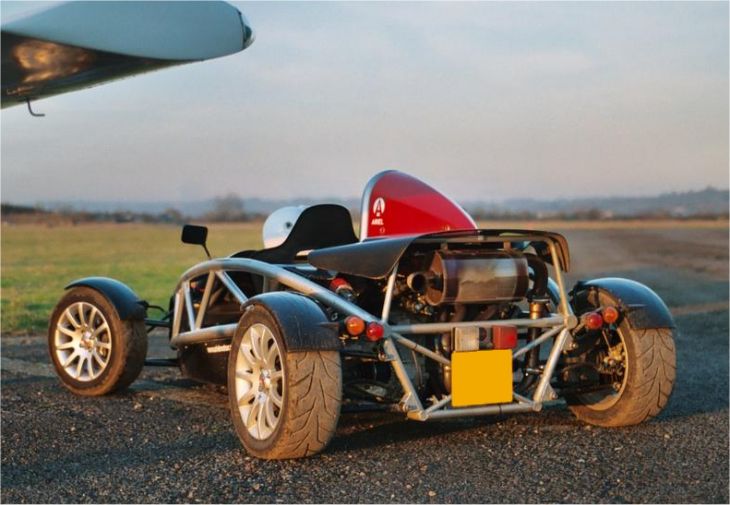The automotive world occasionally witnesses machines that redefine performance paradigms. In 2004, the Ariel Atom 2 emerged as such a revolutionary force — a skeletal speedster that stripped away conventional automotive excess to deliver pure, undiluted driving excellence.
This British-bred track weapon didn’t just challenge supercar conventions; it shattered them. With its exposed chassis and minimalist ethos, the Atom 2 demonstrated how radical weight reduction could transform automotive performance.
Engineering Marvel: The Essence of Minimalism
The Atom 2’s design speaks volumes through its deliberate absences. Every component serves a purpose, resulting in a featherweight chassis weighing just 500-600 kg. The tubular steel frame, exposed to the elements, becomes both structural backbone and visual signature.
Fact!
The Atom 2's power-to-weight ratio exceeded that of many contemporary supercars, despite using a relatively modest 2.0L engine. This achievement highlighted how weight reduction could trump raw power in the pursuit of performance.
«The first time I took the Atom 2 to a track day, I outpaced cars costing five times as much. Its raw, direct connection to the road is unlike anything else I’ve experienced» — James Reynolds, Track Day Instructor at Silverstone.
The dimensional footprint remains compact yet purposeful: 3411mm length, 1798mm width, and 1194mm height. These proportions, combined with the exposed chassis design, create a package that prioritizes handling precision over all else.
Power and Performance: The Honda Heart
At the core of the Atom 2 beats a Honda K20A i-VTEC engine, available in two distinct flavors. The naturally aspirated version delivers 223 hp, while the supercharged variant unleashes 304 hp — both astronomical figures considering the car’s minimal mass.
The key performance metrics tell a compelling story:
- base model acceleration: 0-100 km/h in 4.4 seconds;
- supercharged variant: sub-3 second sprints;
- top speed: exceeding 249 km/h;
- power-to-weight ratio: rivaling Formula 1 cars of the era.
«What makes the Atom 2 special isn’t just the numbers — it’s how the power delivery feels completely unfiltered. Every throttle input translates directly to forward motion with no delay, no hesitation» — Michael Chen, Automotive Engineering Consultant.
Track-Ready Features and Driver Experience
The cockpit epitomizes functional minimalism. A quick-release steering wheel, essential gauges, and perfectly positioned controls create an environment focused purely on the art of driving.
Historical Reference!
Jeremy Clarkson's famous Top Gear review in 2004 became legendary, with his face visibly distorted by the acceleration forces — a testament to the raw performance of the unfiltered Atom 2.
Track capabilities define every aspect of the experience. The suspension geometry, brake balance, and steering ratio work in harmony to deliver feedback that feels hardwired to the driver’s nervous system.
The six-speed manual transmission exemplifies mechanical precision, with short throws and perfectly spaced ratios that keep the engine in its power band.
Legacy and Impact
The Atom 2’s influence extends far beyond its production numbers. It sparked a renaissance in ultralight performance vehicles and proved that sophisticated simplicity could triumph over technological complexity.
Important!
The Atom 2's design philosophy influenced numerous track-focused vehicles that followed, establishing a new category of street-legal track weapons that prioritize power-to-weight ratio over absolute horsepower.
This machine didn’t just set performance benchmarks; it questioned the very foundation of sports car design. Its success demonstrated that the pursuit of pure driving experience could trump luxury and convenience.
The Final Lap: Beyond Numbers
The Atom 2 represents more than performance statistics — it embodies the purest expression of driving enthusiasm. Its legacy lives on in the hearts of enthusiasts who understand that true performance comes not from excess, but from exactitude.
The car’s enduring appeal lies in its honesty. There’s no pretense, no unnecessary adornment — just the essential elements required for extraordinary performance, assembled with British precision and Honda reliability.
Pros & Cons
| Advantages | Disadvantages |
|---|---|
| Exceptional power-to-weight ratio delivering supercar-beating performance | Limited weather protection due to open-cockpit design |
| Unmatched driving purity and feedback | Minimal storage space restricts practical usability |
| Honda K20A engine reliability and tuning potential | Sparse creature comforts make long journeys challenging |
| Outstanding track day capabilities | Limited availability and specialist maintenance required |
| Innovative skeletal design maximizing aerodynamics | Not suitable for daily driving in variable weather |
| Strong collector value and appreciation potential | Requires significant driver skill to exploit full potential |
| Low running costs compared to traditional supercars | Limited passive safety features |
The Ariel Atom 2 (2004) stands as a testament to the power of focused engineering and purposeful design. While it may not suit everyone’s needs as a primary vehicle, it delivers an unmatched driving experience that continues to captivate enthusiasts and collectors alike. Its influence on automotive design philosophy and track-day culture remains significant, marking it as one of the most important driver’s cars of the modern era.

